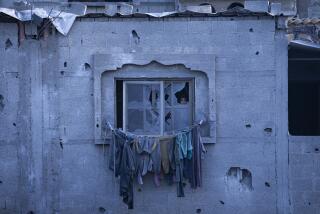Soldier Recalls the Slaying of a Young Human Shield
- Share via
BESLAN, Russia — Mikhail, a soldier who participated in the terrible battle at Middle School No. 1, is matter-of-fact as he describes how Russian commandos killed a young hostage.
“On the second floor, there was one fighter who was covering himself with a child,” Mikhail, who gave only his first name, said Saturday. “The child had to be killed first, and then they killed the terrorist. It was the kind of situation where the guys who had to seize the building weren’t thinking about anything else. They saw a fighter, and destroyed this fighter.
“So of course, friendly casualties were inevitable.”
A day after a battle that would leave 340 hostages dead, participants and witnesses described a scene of bedlam and horror.
The conflagration erupted unexpectedly, so unexpectedly that Russian officials believe now it may well have been an accident. After lacing the building with explosives, investigators believe, hostage-takers who had terrorized 1,000 adults and children for three days may have accidentally pulled the line on one of their own booby traps.
The ensuing explosions prompted several hostages to make a break, and when the guerrillas shot at their captives, Russian commandos outside opened fire. Two hours of intense gunfire and near-pandemonium ensued, as neighborhood men grabbed their own guns to join the fight and bullets began flying in nearly every direction -- even as the hostages, most of them children, were running for safety.
“We drove to the school, and started directing [escaping] children who were running toward us in all possible directions,” Mikhail said. “There’s only one word that can characterize what was happening: chaos. I don’t think there was a strategy or anything. No one had expected anything like this to happen.”
An Emergency Situations Ministry employee, sent in to help evacuate hostages and the injured, said the presence of civilians with guns made the situation dangerous for everyone.
When the firing began, four Emergency Situations employees had just approached the school under an agreement to remove long-dead bodies from outside. “Two of our guys were killed instantly, and two others lay wounded for four hours,” said the employee, who wouldn’t give his name.
“There was this huge crowd of people, most of them with guns, about 500 people, I’d say,” the employee said. “They weren’t doing anything specifically. They were just running around chaotically.”
A special people’s militia had been deputized for the siege, but “they were a classic example of a loose cannon,” he said. “I personally was more afraid of them than I was of the fighters.”
The Russian commandos’ tactic, he said, was to join in firing at a single guerrilla position at a window. When that guerrilla was driven back, “a Spetsnaz [special forces] guy would jump in the window and start handing out hostages to his buddies. Then they’d go to the next window. And all of this was under very intense gunfire, just nonstop gunfire.”
The job of his team, he said, was to get the hostages to safety once the commandos pulled them out of the windows.
“In a situation where there’s just gunfire all over the place, our guys would run through the firing sector up to the building, grab a hostage, and run back,” he said. “There were basically bullets and little pieces of brick and stone flying all over the place.”
The neighborhood around the school, so middle class it looks like it ought to be in Dayton, Ohio, instead of the Russian Caucasus, looked more like Beirut on Saturday.
Residents who were finally allowed to return to their homes found signs of the battle.
“Everything you see there on the floor is blood. There was blood all over the wall there where the children were touching it,” Zara Dudarova, who spent two days as a hostage, said as she stood in the ruins of a guesthouse where dozens of children and other captives fleeing the school sought temporary refuge. A smell like bad meat hung in the air, and the patio outside was littered with shell casings.
Up and down the street, residents swept up broken glass and crumbled bricks from their apartments, many of which had been used as firing positions by Russian commandos.
The potato plants and squash in Dudarova’s garden were flattened, apparently by soldiers who took cover behind her wall. Three armored personnel carriers and a tank had roared up the normally tranquil street, leaving bits of rubble behind.
“I was here the whole time, and the things that were happening here yesterday weren’t even happening during World War II,” said Georgy Beroyev, a 58-year-old resident of the apartment building across from the school. “They were bombing the place so heavily that the whole building was shaking.”
While Beroyev was quaking in his living room armchair, he would learn later, his 10-year-old twin grandsons were dying in the school gymnasium.
The battle, which began shortly after 1 p.m. Friday, continued until after 6. Into the night, Russian forces worked to eject a guerrilla holed up in the basement, reportedly with several hostages.
“By 8 or 9, all the civilians had left here and the military were just finishing off the terrorists,” said a resident of the neighborhood, Artur, who had helped as a militia volunteer all afternoon.
“They asked us to leave,” he said. “They told us they were going to clear the mines, and they wanted us to leave. Whatever they did at the end, they never allowed us to see it.”
*
Alexei V. Kuznetsov of The Times’ Moscow Bureau contributed to this report.
More to Read
Sign up for Essential California
The most important California stories and recommendations in your inbox every morning.
You may occasionally receive promotional content from the Los Angeles Times.










